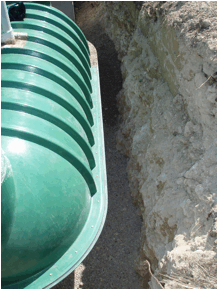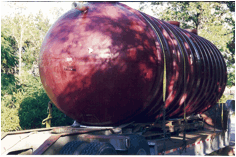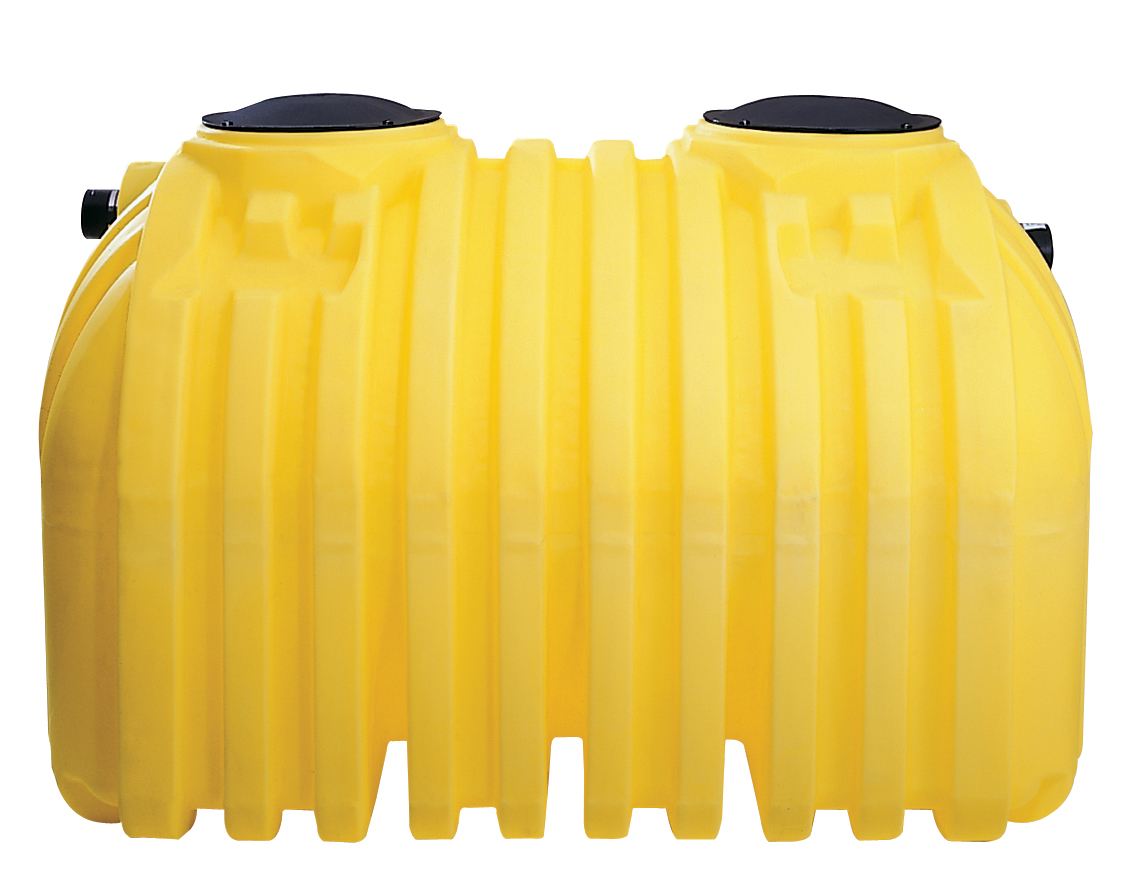Fiberglass (FRP) and Polyethylene Tanks
Fiberglass, or fiber-reinforced plastic, and polyethylene tanks are an alternative to concrete for septic tanks and dosing (pump) tanks.
Tank materials that are absolutely unsuitable are metal or wood. The wastewater environment is very corrosive to metal, and wood biodegrades and rots. The corrosiveness of wastewater is one of the reasons why steel reinforcement (rebar) in concrete tanks should always have at least about 1-2 inches of concrete thickness/cover over/around the rebar (between the rebar and either surrounding air/ground, or wastewater inside the tank).
Fiberglass Tanks
FRP tanks are very resistant to corrosion and can remain watertight for many years (typically much longer than concrete tanks). As much as 50-year warranties are reportedly offered by some manufacturers of FRP tanks, as long as they’re installed and used in accordance with the manufacturer instructions. FRP tanks are available in a very wide range of sizes, up to many thousands of gallons.
FRP tanks are cast in halves and assembled at the factory, or for smaller tanks, can be shipped in half-shells and assembled by trained technicians at a project site. For smaller tanks with gasketed/sealed and flanged connections along the mid-seam (1,000 – 1,500 gallons), some manufacturers prefer to assemble the tanks at the factory. Special training is typically required by manufacturers (and needed) for assembling tank half-shells to make sure that the mid-seam is watertight under all operating conditions. The advantage of shipping tanks in halves is that they can be stacked one inside the other and occupy much less space for a greater number of tanks during transport in shipping containers.
High quality FRP tanks are manufactured with the characteristic ribbing shown in Figure 9 below. The ribbing provides structural support for the external loading from the surrounding soil. However, fiberglass tanks are not typically constructed to handle very much internal loading, which has to be considered during installation and testing for water-tightness. It’s always best to do water-tightness testing on tanks before backfilling them so that any problems found can be corrected without having to remove backfilled material, and to be able to see any slow leaks that might not be detected from water level checks during testing after backfilling. Reinforced concrete tanks (either precast or cast-in-place) have the advantage of being more structurally strong for both internal and external loading, and can therefore be filled with water prior to backfilling. The concrete side walls provide enough structural support for the interior water pressure when the tank is full. FRP tanks require more care during water testing, which may need to be done in stages (filling a foot or so depth at a time, then backfilling, and testing the next depth interval, and so on up to the full depth of the tank). The flange along the middle of the tank shown in Figure 9 helps provide structural support for water pressure prior to backfill.
 Figure 9: A 1,500-gallon fiberglass (FRP) tank installed level in excavated hole, with pea gravel bedding; The tank hole is over-excavated by one foot on all sides to allow for placement without damage to the tank, and for backfilling with pea gravel.
Figure 9: A 1,500-gallon fiberglass (FRP) tank installed level in excavated hole, with pea gravel bedding; The tank hole is over-excavated by one foot on all sides to allow for placement without damage to the tank, and for backfilling with pea gravel.
From: Planning and Installing Sustainable Onsite Wastewater Systems, S.M. Parten, McGraw-Hill, 2009
Figure 10 below shows the above tank backfilled with pea gravel up to the top of the tank, with sand used above that (since from that level up there would be little concern with voids left around or under the tank). For this system, an FRP tank is used for primary settling (septic tank), and a concrete tank is used for dosing the dispersal field with treated effluent draining to the tank from a sand filter treatment unit.
 Figure 10: Fiberglass septic tank backfilled with pea gravel and topped with sand that will be placed up to about 12 inches above the top surface of the tank to just below the riser lids, after the conduit and rest of the piping and conduit are installed (to ensure ample cover over those). The concrete field dosing tank is backfilled, and shown at the top of the photo.
Figure 10: Fiberglass septic tank backfilled with pea gravel and topped with sand that will be placed up to about 12 inches above the top surface of the tank to just below the riser lids, after the conduit and rest of the piping and conduit are installed (to ensure ample cover over those). The concrete field dosing tank is backfilled, and shown at the top of the photo.
Unlike concrete tanks, even very large FRP tanks can be transported on flat bed trailers, and lifted with excavators or other available earth-moving equipment. The tank shown in Figure 10 is an 8,000 gallon tank used for a large commercial scale onsite system. FRP tanks should be manufactured with lifting lugs along the top of the tank for lifting and placement.
 Figure 10: An 8,000-gallon fiberglass (FRP) septic tank to be used for a commercial project, with inlet and outlet piping cast into the tank by the manufacturer. This large tank can be transported on land as shown, strapped to a trailer. Weights of tanks are available from manufacturers to determine suitable means of lifting and placing.
Figure 10: An 8,000-gallon fiberglass (FRP) septic tank to be used for a commercial project, with inlet and outlet piping cast into the tank by the manufacturer. This large tank can be transported on land as shown, strapped to a trailer. Weights of tanks are available from manufacturers to determine suitable means of lifting and placing.
From: Planning and Installing Sustainable Onsite Wastewater Systems, S.M. Parten, McGraw-Hill, 2009
Because FRP tanks are lightweight, and where there may be concerns about groundwater or surface water intrusion (near shorelines), or stability of the tank along slopes, it may be necessary to use anti-flotation or otherwise stabilizing “deadmen” anchors. Deadmen are long and narrow reinforced concrete weights placed on each side of the tank, with strapping across the tank connected to each of the deadmen. Connections should be made using non-corrosive materials. Anti-flotation or other types of stabilization calculations must be done to determine the size of concrete deadmen needed.
 Figure 11: Large FRP tanks with anti-flotation deadmen and anchor straps installed.
Figure 11: Large FRP tanks with anti-flotation deadmen and anchor straps installed.
From: Planning and Installing Sustainable Onsite Wastewater Systems, S.M. Parten, McGraw-Hill, 2009
Polyethylene Tanks
Polyethylene tanks are another type of tank not subject to erosion, and lightweight for placement in difficult site locations. Polyethylene tanks are typically only available in sizes up to about 1,500 gallons due to structural issues with the use of a softer and more pliable material (as compared with FRP). However, for smaller sized tanks, some very long-term warranties are provided by certain manufactures for properly installed polyethylene tanks. These tanks are fabricated using either a rotational or a blow molding process, with each method producing tanks with no seams. As with FRP tanks, ribbing is also used for polyethylene tanks to provide structural strength for external loading from the surrounding ground/soil. Because these tanks are seamless, there are fewer concerns (as compared with FRP tanks) about internal water pressure during tests for water-tightness prior to backfilling. However, since polyethylene is more flexible, there have historically been some problems with these tanks exhibiting at least slight flexing at times when tanks are either filled or emptied (such as when being pumped/cleaned), with resulting leaks around the inlets and/or outlets of the tanks. Improvements in the materials and designs used for polyethylene tanks continue to be made, and are accompanied by fewer problems of this type.
 Figure 12: A 1000-gallon polyethylene septic tank with inlet and outlet pipe fittings installed.
Figure 12: A 1000-gallon polyethylene septic tank with inlet and outlet pipe fittings installed.
From: Planning and Installing Sustainable Onsite Wastewater Systems, S.M. Parten, McGraw-Hill, 2009
Polyethylene tanks should also be placed in over-excavated holes with at least about 9-12 inches of space between the bottom and sides of the excavation, and bedded and backfilled with pea gravel or other material approved by the manufacturer. Pea gravel backfills well behind itself (not leaving voids), and so is preferable to soil or even sand. Concrete anti-flotation deadmen may also be needed for polyethylene tanks, depending on site conditions and location.
Most FRP and polyethylene tank manufacturers provide calibrated tables relating depths of liquid in the tank with volumes. Depending on site conditions and project needs, tanks constructed of different materials might be used for the same project. For example, a non-corrosive fiberglass or polyethylene tank might be used for primary treatment (septic tank), since that wastewater is highly corrosive, while a concrete tank might be used as a pump tank for treated wastewater and dosing a dispersal field (following some method of treatment following primary settling in the septic tank).
Table 4 below compares the various materials used for decentralized wastewater systems tanks today. Each site and situation may be different, so that design engineer should make a determination of the most suitable tank material(s) for each portion of the system.
| Cast-In-Place Reinforced Concrete | Precast Reinforced Concrete | Fiber-Reinforced Plastic (FRP or Fiberglass) | Polyethylene |
| Require structural engineer’s design specific to project; | Tanks pre-engineered by tank manufacturer; Ability to better control quality of construction at manufacturing facility, and pour bottoms and walls of tanks monolithically | Tanks pre-engineered by tank manufacturer; Ability to better control quality of construction at manufacturing facility | Tanks pre-engineered by tank manufacturer; Ability to better control quality of construction at manufacturing facility |
| Requires forming, placing reinforcing steel and pouring tank on-site in excavation, along with proper bedding | Requires heavy truck access close to tank excavation for placement of tank with heavy duty boom and lifting equipment. | Relatively lightweight tanks that can be transported strapped-down on a flat bed trailer, and moved with equipment typically used for construction such as mini-excavators. | Relatively lightweight tanks that can be transported strapped-down on a flat bed trailer, and moved with equipment typically used for construction such as mini-excavators. |
| Concrete is subject to corrosion over time | Concrete is subject to corrosion over time | Very resistant to corrosion | Very resistant to corrosion |
| Greater variability of quality of construction, and dependent on availability of local labor and engineering skills | Monolithically poured bottoms and sidewalls limited to tanks with capacities less than about 2,000 gal. | Available in wide range of sizes, up to very large tanks serving subdivisions and larger commercial projects. | Septic tank sizes typically available up to only about 1,500 gal. operating capacity, due to structural issues |
| If properly designed and built, structural stable for interior and exterior loading and variable water levels | If properly designed and built, structural stable for interior and exterior loading and variable water levels | Tanks structurally designed primarily for exterior loading/pressures, and care must be taken to ensure that sufficient exterior support is provided to balance interior pressures if when filling with water before backfilling. Must consult with manufacturer about acceptable filling levels prior to backfilling. | Have historically had problems with flexing/deformation when backfilling with tank empty, or pumping the tank after installation. Improvements in materials and tank designs by at least some manufacturers have reduced these problems. |
| Top surfaces/lids of tank typically cast separately, requiring sealing between tank walls and lid; Larger tanks have to be poured in several sections with greater opportunity for leaks at joints | Top surfaces/lids of tank cast separately, requiring sealing between tank walls and lid | Tanks are manufactured in half-shells and assembled either by the manufacturer or by trained technicians in the field (for smaller tanks). For smaller tanks shipped in half-shells and assembled elsewhere, half-shells can fit inside each other allowing for shipment of much larger number of tanks for given container/cargo space | Tanks are molded in one piece, using either rotational or blow molding processes. Though lightweight, requires much more space for shipping as compared with smaller diameter FRP tanks that may be shipped in half-shells. |
| Due to weight of tank, flotation of tank and adding ballast are less a concern than for FRP or polyethylene tanks | Due to weight of tank, flotation of tank and adding ballast are less a concern than for FRP or polyethylene tanks | Anti-flotation ballast, or concrete “deadman” weights of appropriate size must be used for flood prone or high ground water areas | Anti-flotation ballast, or concrete “deadman” weights of appropriate size must be used for flood prone or high ground water areas |
| Installation can be difficult along steep slopes or where there’s not sufficient access by heavy equipment | Locations of tank installations must be accessible by heavy trucks | Can be fairly easily moved to difficult locations on sites, as long as adequate space for size of tank | Can be fairly easily moved to difficult locations on sites, as long as adequate space for size of tank |
| Cannot be moved around site after placement | Cannot be moved around site after delivery by typical onsite construction equipment. | Can be moved if needed (if empty) around site by typical onsite construction equipment | Can be moved if needed (if empty) around site by typical onsite construction equipment |
Table 4: Comparison of Septic Tank Materials
From: Planning and Installing Sustainable Onsite Wastewater Systems, S.M. Parten, McGraw-Hill, 2009.
